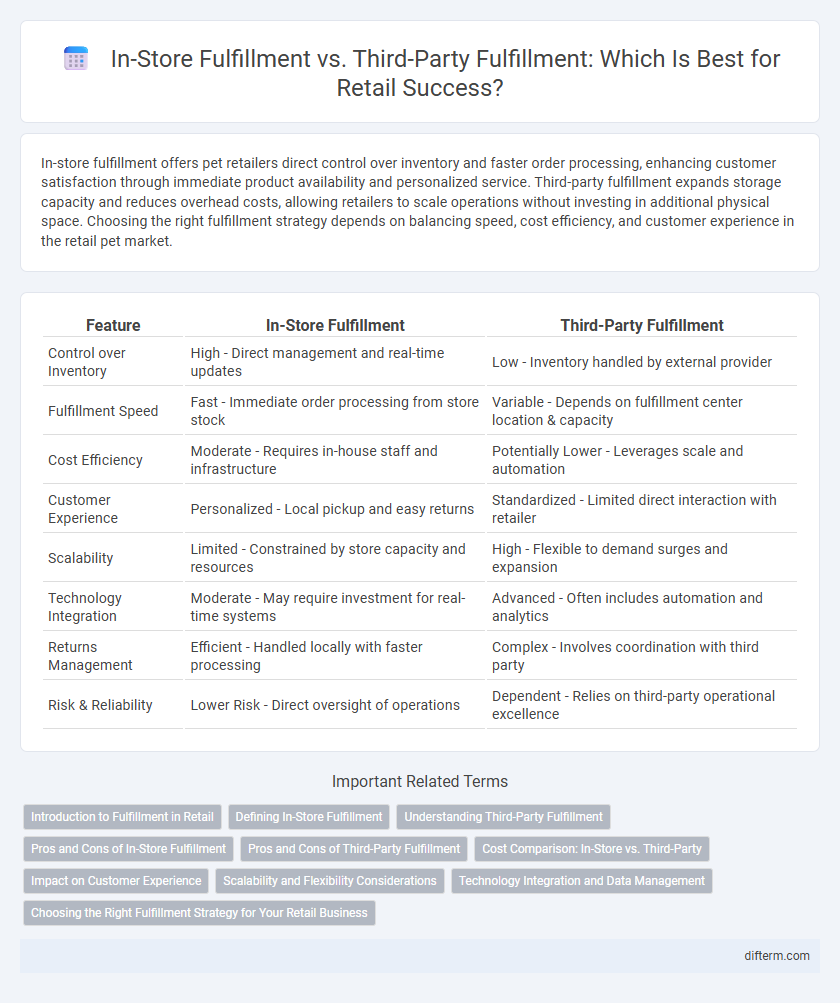In-store fulfillment offers pet retailers direct control over inventory and faster order processing, enhancing customer satisfaction through immediate product availability and personalized service. Third-party fulfillment expands storage capacity and reduces overhead costs, allowing retailers to scale operations without investing in additional physical space. Choosing the right fulfillment strategy depends on balancing speed, cost efficiency, and customer experience in the retail pet market.
Table of Comparison
| Feature | In-Store Fulfillment | Third-Party Fulfillment |
|---|---|---|
| Control over Inventory | High - Direct management and real-time updates | Low - Inventory handled by external provider |
| Fulfillment Speed | Fast - Immediate order processing from store stock | Variable - Depends on fulfillment center location & capacity |
| Cost Efficiency | Moderate - Requires in-house staff and infrastructure | Potentially Lower - Leverages scale and automation |
| Customer Experience | Personalized - Local pickup and easy returns | Standardized - Limited direct interaction with retailer |
| Scalability | Limited - Constrained by store capacity and resources | High - Flexible to demand surges and expansion |
| Technology Integration | Moderate - May require investment for real-time systems | Advanced - Often includes automation and analytics |
| Returns Management | Efficient - Handled locally with faster processing | Complex - Involves coordination with third party |
| Risk & Reliability | Lower Risk - Direct oversight of operations | Dependent - Relies on third-party operational excellence |
Introduction to Fulfillment in Retail
In retail, in-store fulfillment leverages existing physical store locations to process and deliver customer orders, enhancing speed and customer engagement by utilizing store inventory. Third-party fulfillment outsources order processing and shipping to specialized logistics providers, offering scalability and reduced operational complexity for retailers. Both fulfillment methods impact inventory management, delivery timelines, and overall customer satisfaction differently, necessitating strategic consideration based on business goals.
Defining In-Store Fulfillment
In-store fulfillment involves retailers processing and delivering online orders directly from physical store locations, leveraging existing inventory to expedite shipping and enable options like same-day pick-up. This approach reduces last-mile delivery costs and improves customer satisfaction by utilizing local store resources for faster order fulfillment. Retailers can enhance inventory accuracy and increase sales by integrating online and offline channels through real-time stock management in in-store fulfillment.
Understanding Third-Party Fulfillment
Third-party fulfillment involves outsourcing storage, packaging, and shipping processes to specialized logistics providers, enabling retailers to reduce overhead costs and scale operations efficiently. These fulfillment centers leverage advanced inventory management systems and transportation networks to ensure faster delivery times and accurate order tracking. Understanding third-party fulfillment is crucial for retailers aiming to enhance customer satisfaction while minimizing operational complexities and capital investment.
Pros and Cons of In-Store Fulfillment
In-store fulfillment offers faster order processing and enhanced customer experience by allowing immediate product availability and personalized service. However, it requires significant investments in staff training and inventory management, potentially leading to higher operational costs. Limited storage space and the risk of disrupting regular store operations are additional challenges retailers face with in-store fulfillment.
Pros and Cons of Third-Party Fulfillment
Third-party fulfillment offers retailers scalability, reduced overhead costs, and access to advanced logistics technology, enabling faster shipping and improved customer satisfaction. However, it can lead to less control over inventory management, potential communication delays, and reliance on external partners for order accuracy and delivery timeliness. Balancing these advantages and risks is essential for retailers aiming to optimize supply chain efficiency and customer experience.
Cost Comparison: In-Store vs. Third-Party
In-store fulfillment often incurs higher initial investments due to labor and infrastructure but reduces shipping costs and delivery times by leveraging existing retail locations. Third-party fulfillment offers scalable solutions with lower upfront capital but includes additional fees for storage, handling, and shipping that can increase overall expenses. Retailers must analyze order volume, geographic reach, and margin impact to determine the most cost-effective fulfillment strategy.
Impact on Customer Experience
In-store fulfillment enhances customer experience by enabling faster order pickup and easy returns, fostering stronger brand trust and satisfaction. Third-party fulfillment can offer broader delivery options and reduce shipping times in regions without physical stores but may introduce variability in service quality. Retailers must balance control over inventory and personalized service with scalability and geographic reach to optimize customer satisfaction.
Scalability and Flexibility Considerations
In-store fulfillment offers retailers direct control over inventory and customer experience but may face scalability challenges during peak demand due to limited store space and staff capacity. Third-party fulfillment services provide greater flexibility in scaling operations quickly, leveraging extensive warehousing networks and advanced logistics technology to handle fluctuating order volumes efficiently. Retailers must evaluate growth projections and resource availability to determine the optimal balance between in-store agility and third-party scalability.
Technology Integration and Data Management
In-store fulfillment leverages advanced POS systems and RFID technology to synchronize inventory data in real-time, enabling immediate order processing and enhancing customer experience. Third-party fulfillment relies heavily on integrated APIs and cloud-based platforms to manage extensive SKU databases and track shipments across multiple locations efficiently. Both approaches require robust data management solutions to ensure accuracy in stock levels, order statuses, and seamless communication between sales channels and fulfillment centers.
Choosing the Right Fulfillment Strategy for Your Retail Business
Choosing the right fulfillment strategy for your retail business depends on factors such as order volume, customer expectations, and operational capacity. In-store fulfillment leverages existing retail locations for faster delivery and enhanced customer experience, ideal for omnichannel retailers aiming to reduce last-mile costs. Third-party fulfillment offers scalability and expert logistics management, making it suitable for businesses prioritizing efficiency and expansion without the overhead of maintaining physical inventory space.
In-Store Fulfillment vs Third-Party Fulfillment Infographic

 difterm.com
difterm.com